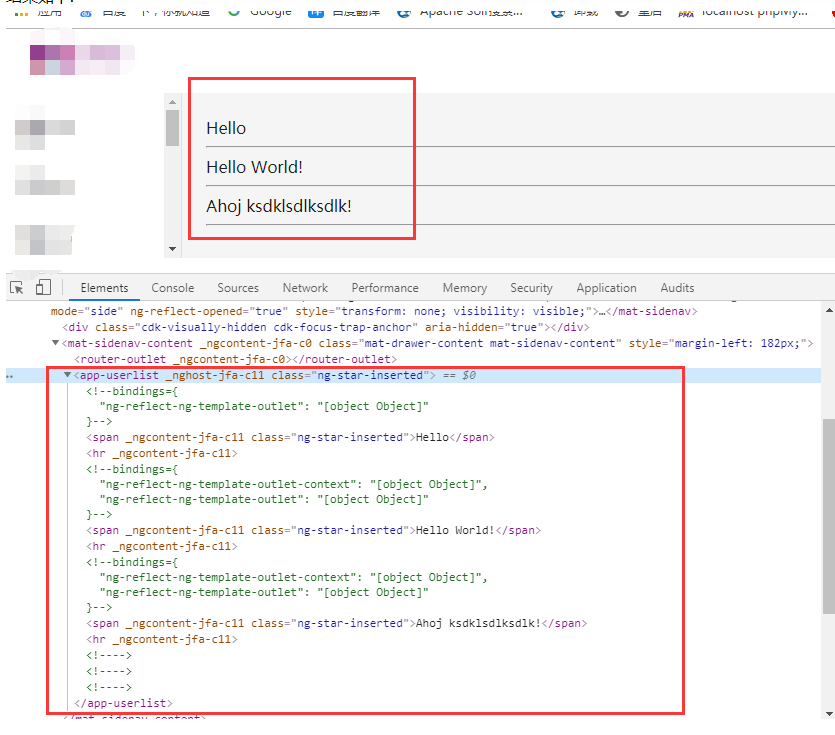NgTemplateOutlet 指令作用
该指令用于基于已有的 TemplateRef 对象,插入对应的内嵌视图。在应用 NgTemplateOutlet 指令时,我们可以通过 [ngTemplateOutletContext] 属性来设置 EmbeddedViewRef 的上下文对象。绑定的上下文应该是一个对象,此外可通过 let 语法来声明绑定上下文对象属性名。
友情提示:若 let 语法未绑定任何属性名,则上下文对象中
$implicit属性,对应的值将作为默认值。
NgTemplateOutlet 指令语法
<ng-container *ngTemplateOutlet="templateRefExp; context: contextExp"></ng-container>NgTemplateOutlet 使用示例
@Component({
selector: 'ng-template-outlet-example',
template: `
<ng-container *ngTemplateOutlet="greet"></ng-container>
<hr>
<ng-container *ngTemplateOutlet="eng; context: myContext"></ng-container>
<hr>
<ng-container *ngTemplateOutlet="svk; context: myContext"></ng-container>
<hr>
<ng-template #greet><span>Hello</span></ng-template>
<ng-template #eng let-name><span>Hello {{name}}!</span></ng-template>
<ng-template #svk let-person="localSk"><span>Ahoj {{person}}!</span></ng-template>
`
})
class NgTemplateOutletExample {
myContext = {$implicit: 'World', localSk: 'Svet'};
}基础知识
TemplateRef
TemplateRef 实例用于表示模板对象。
ViewContainerRef
ViewContainerRef 实例提供了 createEmbeddedView() 方法,该方法接收 TemplateRef 对象作为参数,并将模板中的内容作为容器 (comment 元素) 的兄弟元素,插入到页面中。
若想进一步了解 TemplateRef 和 ViewContainerRef 的相关内容,请参考以下文章:
<ng-template>
<ng-template> 用于定义模板,使用 * 语法糖的结构指令,最终都会转换为 <ng-template> 模板指令,模板内的内容如果不进行处理,是不会在页面中显示。
<ng-container>
<ng-container> 是一个逻辑容器,可用于对节点进行分组,但不作为 DOM 树中的节点,它将被渲染为 HTML中的 comment 元素,它可用于避免添加额外的元素来使用结构指令。
若想进一步了解 <ng-template> 与 <ng-container> 的区别,请参考 Angular 4.x 动态创建组件 文章中我有话说版块。
NgTemplateOutlet 源码分析
NgTemplateOutlet 指令定义
@Directive({
selector: '[ngTemplateOutlet]'
})NgTemplateOutlet 类私有属性及构造函数
export class NgTemplateOutlet implements OnChanges {
// 表示创建的内嵌视图
private _viewRef: EmbeddedViewRef<any>;
// 注入ViewContainerRef实例
constructor(private _viewContainerRef: ViewContainerRef) {}
}NgTemplateOutlet 类输入属性
@Input() public ngTemplateOutletContext: Object; // 用于设定EmbeddedViewRef上下文
@Input() public ngTemplateOutlet: TemplateRef<any>; // 用于设定TemplateRef对象NgTemplateOutlet 指令声明周期
export class NgTemplateOutlet implements OnChanges {
ngOnChanges(changes: SimpleChanges) {
// 若this._viewRef已存在,则先从视图容器中对应的位置移除该视图。
if (this._viewRef) {
this._viewContainerRef.remove(this._viewContainerRef.indexOf(this._viewRef));
}
// 若this.ngTemplateOutlet输入属性有绑定TemplateRef对象,则基于设定的上下文对象创建内嵌视图
if (this.ngTemplateOutlet) {
this._viewRef = this._viewContainerRef.createEmbeddedView(
this.ngTemplateOutlet, this.ngTemplateOutletContext);
}
}
}ngTemplateOutlet 指令的源码相对比较简单,如果读者有兴趣了解 createEmbeddedView() 方法的内部实现,可以参考 Angular 4.x NgIf 文章中的相关内容。
另外需要注意的是使用 let 语法创建模板局部变量,若未设置绑定的值,则默认是上下文对象中 $implicit 属性对应的值。为什么属性名是 $implicit 呢?因为 Angular 不知道用户会如何命名,所以定义了一个默认的属性名。 即 let-name="$implicit" 与 let-name 是等价的。


